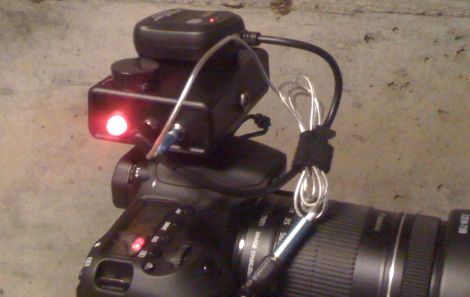
Instructables user [Justin] generally enjoyed shooting video with his Canon 60D DSLR, though there was one small problem. The only way that the camera could be remotely triggered to shoot video was via a small IR remote with a paltry 10 foot range. Even worse, the remote had to be pointed directly at the front of the camera to work at all. To remedy the situation, he decided to rig up his own long-range trigger mechanism.
He cobbled together an Arduino with components he had sitting around, mounting it in a project box on top of the camera. A commercially available RF remote shutter release is also mounted on the top of the camera, and wired to the Arduino using a small 2.5mm plug. When he activates the RF remote, it sends a pulse to the Arduino, which in turn sends the appropriate signal to his camera via a small IR LED.
While he readily admits that he could have likely used a much simpler configuration, the Arduino does its job, and he’s quite happy with his solution. We agree with him about the Arduino, but it’s hard to argue with saving money by using components you already have on-hand.















uhm….
im just putting it out there as an option..
what about just taking apart that 2$ ebay ir remote. and hook that RF remote
directly to its button..
possibly through a transistor if needed.
and loosing that arduino all together
smaller box. and much longer battery life!…
just sayin..
Or commanding the camera through the USB port… sounds like he did not research it much, the command protocol os documented online and people have duinos doing things to these canon cameras.
Anyone know if the Canon camera can “talk back”? Or if there is a START-RECORDING & STOP-RECORDING IR command? I ask as with most video cameras the record button is a toggling function. Which always leaves me wondering “am I recording now?”.
@fartface(“no offense”)
Assuming the Canon is a USB peripheral, that would mean, in order to control it, you would need a USB host. Not something easy to do! In fact, most embedded processor are not up to it.
Anyone know if any variation of an Arduino is up to it (being a USB host)?
This could also likely be done useing a launchpad. Which would Mean it could be cheaply reproduced, have an illogically high battery life, it would be tiny and maby even microscopic compared to haveing a whole arduino board in there, quicker response time due to no bootloader, he wouldent have to change much due to that awesome new package that pretty much makes it so it can use arduino sketches, and the list of benefits goes on and on! And as a plus to the community of ppl who rushed to get em it would be getting use out of their launchpads
Shoulda used a launchpad. The bonuses of useing one is almost endless. Includeing a rediculous battery life. And ppl would actually get use of the damn things because they aren’t used often compared to an arduino yet there are tons of em floating around.
There is a small headphone jack on the side too that can control basic features. Depending on what you ground you can either focus the camera or take a picture.
I think if it’s set to video that will initiate video capture. The library of Canon USB commands can be found here:
http://www.circuitsathome.com/category/camera-control
@Renee – The 2.5mm jack on the side does NOT control video unfortunately, otherwise, I wouldn’t have had to go thru all the trouble, I would have just used the off-the-shelf remote. USB control might be a great project enhancement down the road.
@Fartface – Price, time and my limited knowledge were taken into consideration. I saw the USB option, but researching it, figuring it out, buying the extra parts, etc weren’t what I was looking for. I used what I had and a trip to the local electronics store.
To everyone else, thanks! I know there are simpler, cheaper, easier ways to do this. I used what I had on hand. Keep the ideas coming.
@Renee
The one thing that the jack cannot do is trigger video. The only way to stop/start video recording is with the button on the back of the camera or the IR. Not sure about video over USB though. I know if you trigger the jack while you are doing video it will make the camera take a still. Just like the shutter button, after all the button and jack are wired parallel.